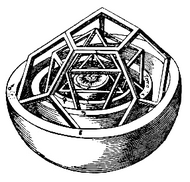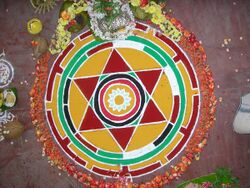Sacred geometry

Sacred geometry ascribes symbolic and sacred meanings to certain geometric shapes and certain geometric proportions.[1] It is associated with the belief that a god is the geometer of the world. The geometry used in the design and construction of religious structures such as churches, temples, mosques, religious monuments, altars, and tabernacles has sometimes been considered sacred. The concept applies also to sacred spaces such as temenoi, sacred groves, village greens and holy wells, and the creation of religious art.
As worldview and cosmology
The belief that a god created the universe according to a geometric plan has ancient origins. Plutarch attributed the belief to Plato, writing that "Plato said god geometrizes continually" (Convivialium disputationum, liber 8,2). In modern times, the mathematician Carl Friedrich Gauss adapted this quote, saying "God arithmetizes".[2]
As late as Johannes Kepler (1571–1630), a belief in the geometric underpinnings of the cosmos persisted among some scientists.[3]
Natural forms

According to Stephen Skinner, the study of sacred geometry has its roots in the study of nature, and the mathematical principles at work therein.[4] Many forms observed in nature can be related to geometry; for example, the chambered nautilus grows at a constant rate and so its shell forms a logarithmic spiral to accommodate that growth without changing shape. Also, honeybees construct hexagonal cells to hold their honey. These and other correspondences are sometimes interpreted in terms of sacred geometry and considered to be further proof of the natural significance of geometric forms.
Art and architecture
Geometric ratios, and geometric figures were often employed in the designs of ancient Egyptian, ancient Indian, Greek and Roman architecture. Medieval European cathedrals also incorporated symbolic geometry. Indian and Himalayan spiritual communities often constructed temples and fortifications on design plans of mandala and yantra.
Many of the sacred geometry principles of the human body and of ancient architecture were compiled into the Vitruvian Man drawing by Leonardo da Vinci. The latter drawing was itself based on the much older writings of the Roman architect Vitruvius.
Islamic geometric patterns are well known too, which are used in the Qu'ran, Mosques and even in the caligraphies of personal names.
In Hinduism

The Agamas are a collection of Sanskrit,[5] Tamil, and Grantha[6] scriptures chiefly constituting the methods of temple construction and creation of idols, worship means of deities, philosophical doctrines, meditative practices, attainment of sixfold desires, and four kinds of yoga.[5]
Elaborate rules are laid out in the Agamas for Shilpa (the art of sculpture) describing the quality requirements of such matters as the places where temples are to be built, the kinds of image to be installed, the materials from which they are to be made, their dimensions, proportions, air circulation, and lighting in the temple complex. The Manasara and Silpasara are works that deal with these rules. The rituals of daily worship at the temple also follow rules laid out in the Agamas.
Unanchored geometry
Stephen Skinner discusses the tendency of some writers to place a geometric diagram over virtually any image of a natural object or human created structure, find some lines intersecting the image and declare it based on sacred geometry. If the geometric diagram does not intersect major physical points in the image, the result is what Skinner calls "unanchored geometry".[7]
See also
- Circle dance
- Harmony of the spheres
- Lu Ban and Feng shui
- Magic circle
- Shield of the Trinity
References
- ↑ dartmouth.edu: Paul Calter, Polygons, Tilings, & Sacred Geometry
- ↑ Cathérine Goldstein, Norbert Schappacher, Joachim Schwermer, The shaping of arithmetic, p. 235.
- ↑ Calter, Paul (1998). "Celestial Themes in Art & Architecture". Dartmouth College. https://www.dartmouth.edu/~matc/math5.geometry/unit10/unit10.html. Retrieved 5 September 2015.
- ↑ Skinner, Stephen (2009). Sacred Geometry: Deciphering the Code. Sterling. ISBN 978-1-4027-6582-7.
- ↑ 5.0 5.1 Grimes, John A. (1996). A Concise Dictionary of Indian Philosophy: Sanskrit Terms Defined in English. State University of New York Press. ISBN:9780791430682. LCCN 96012383. [1]
- ↑ Nagalingam, Pathmarajah (2009). The Religion of the Agamas. Siddhanta Publications. [2]
- ↑ Stephen Skinner, Sacred geometry: deciphering the code, p91
Further reading
- Bain, George. Celtic Art: The Methods of Construction. Dover, 1973. ISBN:0-486-22923-8.
- Bromwell, Henry P. H. (2010). Townley, Kevin. ed. Restorations of Masonic Geometry and Symbolry: Being a Dissertation on the Lost Knowledges of the Lodge. Lovers of the Craft. ISBN 0-9713441-5-9. http://www.kevintownley.com/products/books/restoration-of-masonic-geometry-and-symbolry/. Retrieved Jan 7, 2012.
- Bamford, Christopher, Homage to Pythagoras: Rediscovering Sacred Science, Lindisfarne Press, 1994, ISBN:0-940262-63-0
- Critchlow, Keith (1970). Order In Space: A Design Source Book. New York: Viking.
- Critchlow, Keith (1976). Islamic Patterns: An Analytical and Cosmological Approach. Schocken Books. ISBN 0-8052-3627-9.* Lawlor, Robert. Sacred Geometry: Philosophy and practice (Art and Imagination). Thames & Hudson, 1989 (1st edition 1979, 1980, or 1982). ISBN:0-500-81030-3.
- Iamblichus; Robin Waterfield; Keith Critchlow; Translated by Robin Waterfield (1988). The Theology of Arithmetic: On the Mystical, Mathematical and Cosmological Symbolism of the First Ten Numbers. Phanes Press. ISBN 0-933999-72-0.
- Johnson, Anthony: Solving Stonehenge, the New Key to an Ancient Enigma. Thames & Hudson 2008 ISBN:978-0-500-05155-9
- Lesser, George (1957–64). Gothic cathedrals and sacred geometry. London: A. Tiranti.
- Lippard, Lucy R. Overlay: Contemporary Art and the Art of Prehistory. Pantheon Books New York 1983 ISBN:0-394-51812-8
- Mann, A. T. Sacred Architecture, Element Books, 1993, ISBN:1-84333-355-4.
- Michell, John. City of Revelation. Abacus, 1972. ISBN:0-349-12320-9.
- Schneider, Michael S. A Beginner's Guide to Constructing the Universe: Mathematical Archetypes of Nature, Art, and Science. Harper, 1995. ISBN:0-06-092671-6
- Steiner, Rudolf; Creeger, Catherine (2001). The Fourth Dimension : Sacred Geometry, Alchemy, and Mathematics. Anthroposophic Press. ISBN 0-88010-472-4.
- The Golden Mean, Parabola magazine, v.16, n.4 (1991)
- West, John Anthony, Inaugural Lines: Sacred geometry at St. John the Divine, Parabola magazine, v.8, n.1, Spring 1983.
External links

